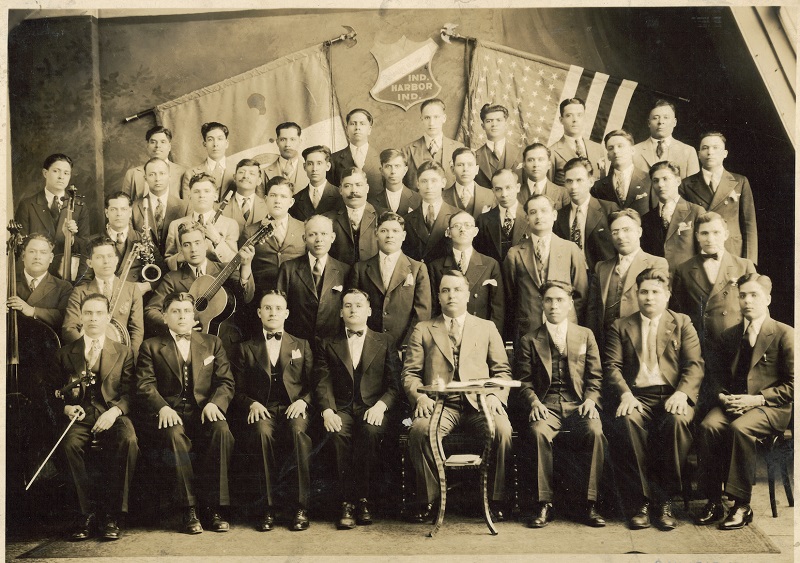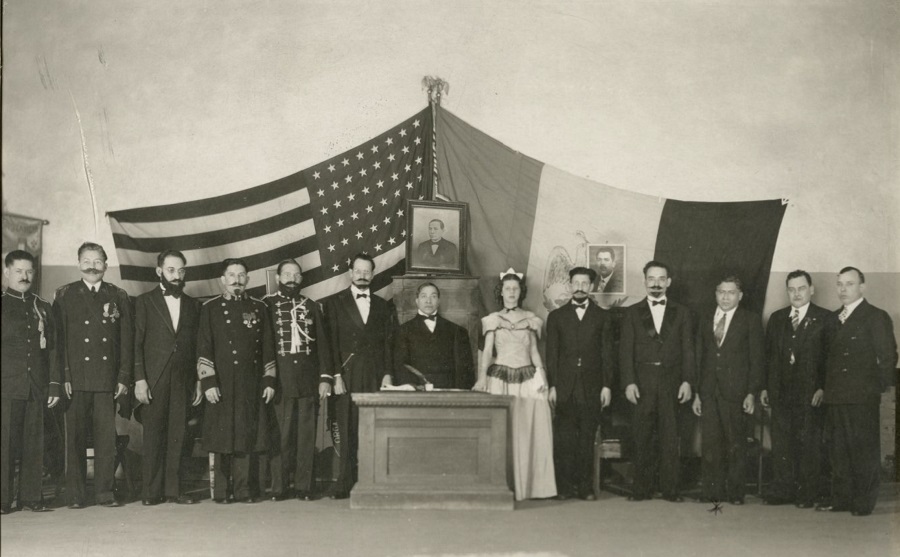
Purchase Tickets
Latino Arts Movement of the Early Twentieth Century
October 4, 2023

Expanding the narrative of Latino history in the Indiana might be called by some, “filling in the gap,” but really it is filling in what I call the in between. From my observation, the general perception of Latino history in the Midwest is that Latinos are either seen as foreigners or farmworkers, with nothing much in the middle. Within this expansive “in between,” we explore the arts and how it played a critical role in the early Latino community.
Art Movement of the early Midwestern Mexican Diaspora, 1922-1928:
1927- 1928: Cuadro Dramático
1920s in Indiana Harbor was a period of cultural vibrancy where traditions and the present-day community anchor institutions were established. The earliest Mexican colonies were in Indiana Harbor (East Chicago) and in the city of Gary, with Indiana Harbor serving as its epicenter.
Per the U.S. Census in 1920, 10% (over 300 individuals) of the total population in Indiana Harbor were Mexican nationals; seven families and the rest were single males who were known as solos. Between 1920 and 1930 the Indiana Harbor population grew from over 300 to over 5,300 individuals, roughly a 1,700% increase. This Midwestern Mexican Diaspora was fueled by the need for foreign labor in the name of war relief (WWI), the lure of steady and well-paying industrial work, and the need for safety as political and religious refugees from the Mexican Revolution. In Indiana Harbor, this resulted in a diverse mix of education and socioeconomic backgrounds in one small community, unanimously unified in their desire for belonging and for the preservation of their culture. One such example of a cultural organization situated in this community was Cuadro Dramático. This local theatre group only existed for a few years in the 1920s, but it held a residency at Auditorium Hall (Michigan Avenue and Grand Boulevard).
According to researcher, Nicolas Kanellos, there were several social societies or mutual aid societies that financially sponsored their plays. One group was The Circulo de Obreros Catolicos “San Jose” (Catholic Workers Circle, “St. Joseph”) which was founded in the early 1920s. The Circulo de Obreros purpose was to raise funds for the construction of a church, a library, the promotion and the welfare of fellow Mexicans, education of their children, and providing wholesome forms of recreation. They achieved their goals with the establishment of Our Lady of Guadalupe Church in 1926 and a small community library housed in the Figueroa Print Shop. The “wholesome recreation” that helped raise funds for the church was achieved by Cuadro Dramático. Its artistic director was J. Jesus Cabrera, who brought scripts of plays that were also being performed in Mexico City. From March 1927 to May 1928 this theatre troupe performed at total of nine full scale plays, some of classical origin, like The Count of Monte Cristo. The theatre group dissipated after J. Jesus Cabrera returned to Mexico or passed away in Indiana Harbor in 1929 (confirmation of either detail is uncertain). Kanellos wrote of Cuadro Dramático’s contribution in the 1973 publication, The Latin American Theatre Review from the University of Kansas. He interviewed past actors and others involved the theatrical troupe, dispelling common misconceptions of this early community during a period of remarkable cultural vibrancy.
“Thus, one acquires the misconception that the Mexican communities consist of mostly illiterate laborers who are not refined, educated nor cultured enough to appreciate the artist dramas that gain audience approval in Mexico City and other cultural centers of the Spanish-Speaking world.” — Nicolas Kanellos, Mexican Community Theatre in a Midwestern City, Latin American Theatre Review, Center of Latin American Studies, University of Kansas, 1973
1922- 1928: The Mexican Band
Another Indiana Harbor discovery was a musical group, anonymously known as “The Mexican Band”. It is important to note that this was a Mexican classical music band and not a Mariachi band. The earliest newspaper mention of this band was in 1922, when they were listed as musical performers at a benefit stag for the Carmelite Home Orphanage at Szabo Hall (4720 Olcott Avenue). Their band leader at the time was identified as Professor Lopez. Years later in September 1926, the Mexican Band performed at the annual Fiestas Patrias ball at Auditorium Hall (Michigan Avenue and Grand Boulevard), where Cuadro Dramático’s artistic director, J. Jesus Cabrera gave a patriotic reading of a poem titled “Mexico.” In August 1927, a Mexican band was giving free outdoor performances at Alder Park on Sunday Afternoons. This time, they had the name, Obreros Mexicanos (Mexican Workers), led by M.G. Arcos. That same year they played at the East Chicago Labor Day parade and the Lake County Fair. Some of the band members (photo below) were members of Circulo de Obreros Catolicos “San Jose” (Catholic Workers Circle, “St. Joseph”), hence the group name and shared members. The last mention of the band is in April of 1928, where they played on the rooftop of a settlement house, Katherine House (138th and Deodar Street) during a sunrise Easter service. Whether this was the same band with a change of leadership, no one knows. Unfortunately, “Mexican Band” is a de facto name given to many bands during this era, rendering them all anonymous.
Through my research I discovered that in April 1923 Gennett Records of Richmond, Indiana, recorded Gonzalez’s Mexican Band (no Indiana connection). To listen to what a 1920s Mexican Band sounded like, click here to listen to the song: La Golondrina (The Swallow), Gennett Record No. 5073 B, Matrix 8229.
From 1922 – 1928 The Mexican American cultural arts scene self-funded the first of three church buildings for Our Lady of Guadalupe Church, a community library, and cultural education programs through music and classical theatrical productions. In the early 1930s the Depression and the Mexican Repatriation Movement systematically saw the removal many of its community members back to Mexico. The once burgeoning and fast-growing cultural arts scene would suffer, returning to limited theatrical performances in the mid to late 1930s and 1940s. Latinos in Indiana, through the arts, planted the seeds that flourish today.

Obreros Mexicanos Band of Indiana Harbor, circa late 1920s. Courtesy of Irene Figueroa and Lydia Castillo
Pictured above is Francisco Figueroa (second row, third from right) who was a print shop owner, editor, and reporter for the Indiana Spanish Language Newspaper El Amigo del Hogar (Friend of the Home) and prominent member of of Circulo de Obreros Catolicos “San Jose” (Catholic Workers Circle, “St. Joseph”). His future son-in-law, Michael Castillo, Sr. is in the top row, fourth from right. Presumably, M.G. Arcos is seated in the front row, center, seated behind the table. Behind Arcos, to his right is Jose Anguiano.

Rosemarie Clarkson with Actors, circa 1930s. Rosemarie I. Gomez, IHS, 2017.0274 (cropped)
Above, Rosemarie (Clarkson) Gomez (sixth from right) stands with other Indiana Harbor theatrical performers, portrays Princess Agnes Salm-Salm, an American woman who petitioned for the Emperor Maximiliano’s life to President Benito Juarez (seventh from center) in 1867. Professor Alonzo (third from right) gave Spanish lessons in Indiana harbor.








